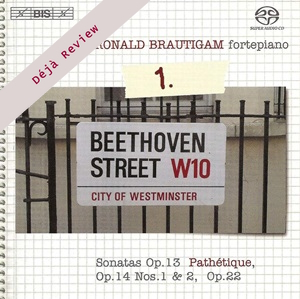
Déjà Review: this review was first published in November 2004 and the recording is still available.
Ludwig van Beethoven (1770-1827)
Complete Works For Solo Piano – Volume 1
Sonata No 8 in C minor, Op 13, ‘Pathétique’ (1797/98)
Sonata No 9 in E, Op 14 No 1 (1797?)
Sonata No 10 in G, Op 14 No 2 (1797?)
Sonata No 11 in B-flat, Op 22 (1800)
Ronald Brautigam (fortepiano by Paul McNulty, after Walther & Sohn c1802).
rec. 2003, Österåker Church, Sweden
BIS BISSACD1362 [70]
After Haydn and Mozart’s complete solo keyboard music (spread over 11 and 10 volumes respectively), Ronald Brautigam here embarks on the greatest exploration of them all: the complete Beethoven works for solo piano. This is the first of a planned series of seventeen discs. Typically for BIS, the art-work is slightly off-the-wall and certainly more appealing for it – better than yet another portrait repro of Ludwig, anyway. And Beethoven Street, W10, really does exist (just near Queen’s Park tube).
Quite why Volume 1 begins with Op 13 and yet seems to present the chosen sonatas in chronological order is unclear. Perhaps BIS wanted to start with a famous one and the Op 2 set will appear as Volume 2 – probably with Op 7 attached? Certainly, the opening shows off the fortepiano to superb effect. This is aided by the spacious and crystal-clear recording. The closely-spaced C minor chord is remarkably dark, sforzandi are sharper than on a piano and appoggiaturas take on great Affekt. Brautigam gives the epoch-making introduction space, as if to point out its import for music generally, and the piano sonata in particular; things would never really be the same again after this. The Allegro di molto e con brio has plenty of momentum and comes equipped with repeat, back to the beginning of the allegro. Brautigam’s is an animated reading, with textures always carefully considered and fully clarified; again, the instrument helps.
The famous A-flat slow movement feels more on the surface as an interpretation. It flows well enough, but here voicing is not all it surely could be, and the bass-line’s import is surely under-represented here. Nice shadings in the middle section cannot rescue it. A graceful finale includes much cheeky counterpoint and great finger strength.
The fortepiano allows superb definition in the lower registers. Rapid triplets low down in this finale of the ‘Pathétique’, for example, come over with remarkable clarity (and take on an extra buzz of excitement because of it).
The two Sonatas Op 14 have both provided plenty of teachers with material, and have become hackneyed because of it. Brautigam plays the E major (No 1) freshly and intelligently. There is much four-part writing here, and Brautigam teases out the voices intelligently. His ornaments are clean, the whole eminently Haydnesque. There is no slow movement in this sonata, just a shifting Allegretto with a simple, reposeful Trio. A pity, and a surprise, that left-hand triplets are muddied in the finale, because this is a committed reading with more drama than is often accorded it.
The G major is given a fluent reading, again more violent in places than expected. The up-front recording helps this impression. The Andante is brisk and charming, with nice textural contrasts towards the end. The playful 3/8 finale is pure Haydn with a brutish ouch, rumbustious to the end. The final bass three-note figure emerges as a gruff comment from the composer himself!.
The Op 22 Sonata – a great Richter favourite – is notoriously tricky, particularly the first movement. Brautigam has no problems in that department. For some reason, though, the sound seems more echoey here. By emphasising the Haydnesque here again, Brautigam makes the rugged development work persuasively. If one is aware of the increased difficult in legato with this instrument in the Adagio con molto espressione, one is also more aware of the exploratory nature of some of Beethoven’s more advanced writing, both in sonority and in harmonies chosen.
Maybe I will warm to Brautigam’s clipped approach to the Minuetto; certainly the resolute left-hand in the Trio is far more notable and convincing. More charm easing in to the finale would not have gone amiss, but this seems to reflect Brautigam’s view of this movement as a whole, as an outwardly approachable statement that nevertheless houses momentous things at work.
There is never any doubt as to either the time Brautigam has spent considering these texts, nor of his fresh viewpoint and its careful realisation. Indeed, there is much to enjoy and I eagerly await the next volume.
My previous reviewing experience of Beethoven Sonatas on the fortepiano comes in the form of Malcolm Bilson on Claves, that I reviewed in December 2002. Bilson used four different instruments, so the much later Op 101 is clearly on a more developed instrument, for example. Brautigam, in contrast, plays four sonatas linked in time so of course plays them all on the same instrument – as I have reported, with exemplary conviction. It will be fascinating to see how Brautigam progresses.
Colin Clarke
Help us financially by purchasing from




















